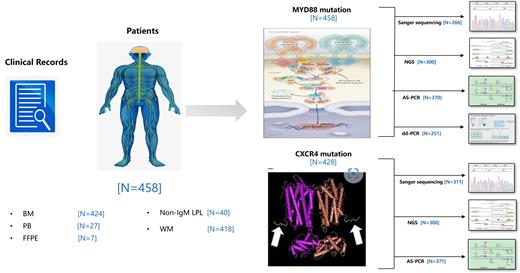Introduction
Waldenström macroglobulinemia (WM)/lymphoplasmacytic lymphoma (LPL) is a rare B-cell lymphoma with prevalent somatic mutations, including MYD88 and CXCR4. However, their mutation rates in Chinese LPL/WM and the comparison of different detection methods remain unclear. Moreover, the clinical implications of MYD88 and CXCR4 mutations in the immunochemotherapy and targeted therapy eras need exploration.
Methods
This study included 458 LPL/WM patients (418 WM, 40 non-IgM LPL) from December 2014 to June 2023. Four methods, such as Sanger sequencing, next-generation sequencing (NGS), allele-specific quantitative polymerase chain reaction (AS-PCR), and droplet digital polymerase chain reaction (ddPCR), were used to detect MYD88L265P and CXCR4 mutations. Demographic data, clinical characteristics, tumor burden, cytogenetic abnormalities, treatment regimens, and survival data were collected.
Results
A total of 458 patients were assessed for MYD88 L265P mutation, of whom 266 were tested by Sanger sequencing, 300 by NGS, 370 for AS-PCR, 251 for ddPCR. The MYD88 L265P mutation was found in 398/458 (86.9%) of the patients. AS-PCR and ddPCR showed the highest sensitivity (97.2% and 96.5%, respectively), outperforming Sanger sequencing and NGS, which had higher false-negative rates in low tumor load patients. A high false-negative rate for MYD88 by Sanger sequencing and NGS was observed in patients with tumor burden less than 10% (40.0% and 21.9% respectively). There was no significant difference in the MYD88 mutation rate detected by ddPCR and ASPCR among patients with different tumor burden groups (P=0.402, P=0.252). MYD88 mutation was detected in a high incidence of 86.7% and 85.5% in less than 1% infiltrated WM tumor cells specimens by ddPCR and ASPCR. Thus, ddPCR and ASPCR assay were effective and accurate enough for un-sorted low infiltrated WM specimens.
CXCR4 mutation testing was performed in 428 patients of LPL/WM, comprising 311 with Sanger sequencing, 300 with NGS, and 371 with AS-PCR. Overall, 31.8% (136/428) patients were identified as having the CXCR4 mutation. NGS exhibited the highest sensitivity (79.2%) among the three detection means.
Among the 458 patients of LPL/WM, 60 (13.1%) were classified as MYD88 wild-type patients. MYD88 wild-type patients had a significantly lower hemoglobin levels (median 83g/L vs. 92g/L, P=0.044), lower proportion of males (56.7% vs. 72.5%, P=0.012) and a significantly higher proportion elevated β2-macroglobulin (81.5% vs. 68.5%, P=0.027), and lactic dehydrogenase (32.2% vs. 11.1%, P<0.001). However, there were no significant differences in either PFS or OS between MYD88 L265P wild-type and MYD88 L265P mutation group (PFS: median 35.7 months vs. 52.9 months, P=0.40; OS: 5-year rate 72.0% vs. 81.8%, P=0.62). MYD88 wild-type patients had worse PFS and post-BTKi failure-free survival under immunochemotherapy (median 34.3 months vs. 58.4 months, P=0.03), and BTKi regimens (median: 26.2 months vs. 45.2 months, P=0.02), respectively. Patients with CXCR4 mutation tended to be older (median 64 vs. 60, P=0.001), had lower hemoglobin levels (median 83g/L vs. 94g/L, P=0.008), and higher baseline BM involvement (by FCM, median 12.6% vs. 6.2%, P<0.001) compared with CXCR4 wild-type patients. The proportion of patients with thrombocytopenia (43.7% vs. 20.6%, P<0.001), serum IgM level more than 40g/L (47.4% vs. 34.6%, P=0.019) was significantly higher, the proportion of patients with low risk profile of IPSSWM (17.2% vs. 30.5%, P=0.007) was significantly lower in mutation group. Notably, CXCR4 mutation group had significantly worse survival compared with the wild-type group (PFS: median 40.5 months vs. 62.5 months, P=0.024; OS: median 103.8 months vs. not reached, P=0.022). Meanwhile, patients with CXCR4 mutation experienced inferior post-BTKi failure-free survival (median 30.4 months vs. 57.6 months, P=.04) and post-BTKi overall survival (3-year rate 71.9% vs. 84.9%, P=0.03) in BTKi therapy groups.
Conclusions
This study sheds light on MYD88 and CXCR4 mutations in Chinese WM/LPL based on a large cohort. AS-PCR and ddPCR were highly sensitive for MYD88 mutation detection, especially in low infiltrated WM. NGS was the most sensitive method for detecting CXCR4 mutation. MYD88 mutation had prognostic significance in BTKi-based therapy, while CXCR4 mutation indicated higher tumor burden and inferior survival in BTKi-based therapy.
Disclosures
No relevant conflicts of interest to declare.


This feature is available to Subscribers Only
Sign In or Create an Account Close Modal